weight PORSCHE 911 TARGA4 2013 6.G Information Manual
[x] Cancel search | Manufacturer: PORSCHE, Model Year: 2013, Model line: 911 TARGA4, Model: PORSCHE 911 TARGA4 2013 6.GPages: 54, PDF Size: 8.37 MB
Page 8 of 54
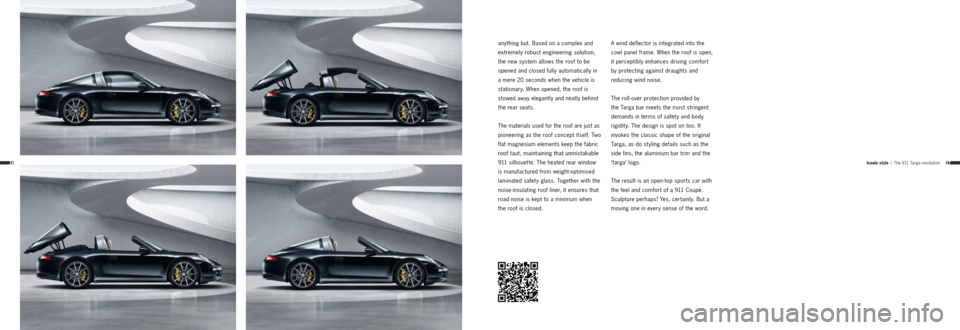
1716Iconic style | The 911 Targa revolution
any thing but. Based on a complex and
extremely robust engineering solution,
the new system allows the roof to be
opened and closed fully automatically in
a mere 20 seconds when the vehicle is
stationary. When opened, the roof is
stowed away elegantly and neatly behind
the rear seats.
The materials used for the roof are just as
pioneering as the roof concept itself. Two
flat magnesium elements keep the fabric
roof taut, maintaining that unmistakable
911 silhouette. The heated rear window
is manufactured from weight- optimised
laminated safet y glass. Together with the
noise-insulating roof liner, it ensures that
road noise is kept to a minimum when
the roof is closed. A wind deflector is integrated into the
cowl panel frame. When the roof is open,
it perceptibly enhances driving comfort
by protecting against draughts and
reducing wind noise.
The roll- over protection provided by
the Targa bar meets the most stringent
demands in terms of safet y and body
rigidit y. The design is spot on too. It
invokes the classic shape of the original
Targa, as do st yling details such as the
side fins, the aluminium bar trim and the
‘ targa’ logo.
The result is an open-top sports car with
the feel and comfort of a 911 Coupé.
Sculpture perhaps? Yes, certainly. But a
moving one in every sense of the word.
Page 16 of 54
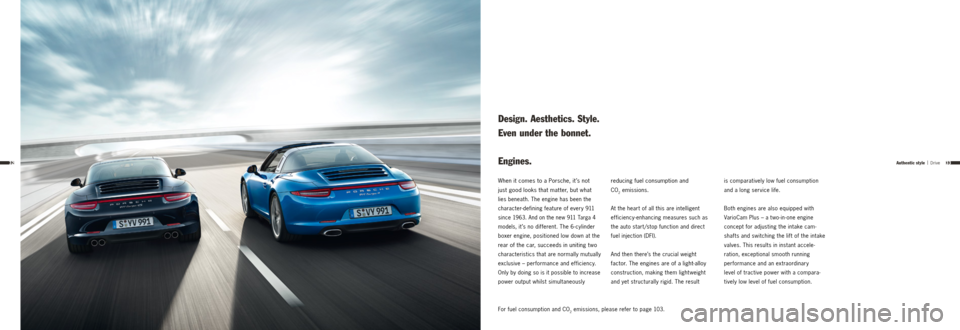
3332Authentic style | Drive
For fuel consumption and CO2 emissions, please refer to page 103.
When it comes to a Porsche, it ’s not
just good looks that mat ter, but what
lies beneath. The engine has been the
character-defining feature of every 911
since
1963. And on the new 9 11 Targa 4
models, it ’s no different. The 6- cylinder
boxer engine, positioned low down at the
rear
of the car, succeeds in uniting t wo
characteristics that are normally mutually
exclusive – performance and efficiency.
Only by doing so is it possible to increase
power output whilst simultaneously
reducing fuel consumption and
CO
2 emissions.
At the heart of all this are intelligent
efficiency-enhancing measures such as
the auto start/stop function and direct
fuel injection (DFI).
And then there’s the crucial weight
factor. The engines are of a light-alloy
construction, making them lightweight
and yet structurally rigid. The result
Design. Aesthetics. Style.
Even under the bonnet.
Engines.
is comparatively low fuel consumption
and a long service life.
Both engines are also equipped with
VarioCam Plus – a two-in-one engine
concept for adjusting the intake cam -
shafts and switching the lift of the intake
valves. This results in instant accele -
ration, exceptional smooth running
performance and an extraordinary
level of tractive power with a compara -
tively low level of fuel consumption.
Page 21 of 54
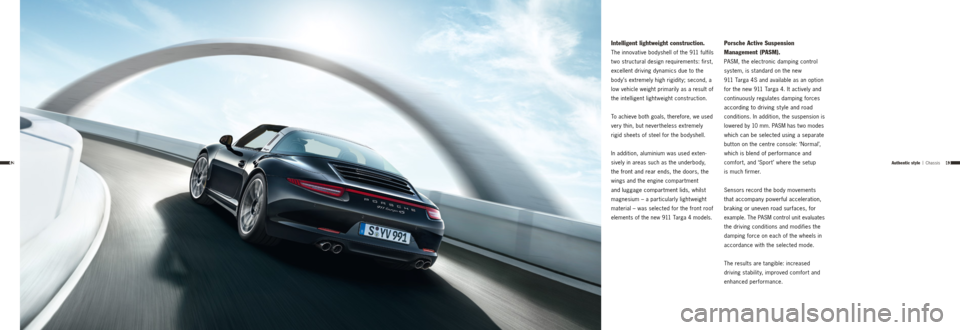
4342
Intelligent lightweight construction.
The innovative bodyshell of the 911 fulfils
t wo structural design requirements: first,
excellent driving dynamics due to the
body’s extremely high rigidit y; second, a
low vehicle weight primarily as a result of
the intelligent lightweight construction.
To achieve both goals, therefore, we used
very thin, but nevertheless extremely
rigid sheets of steel for the bodyshell.
In addition, aluminium was used exten -
sively in areas such as the underbody,
the front and rear ends, the doors, the
wings and the engine compartment
and luggage compartment lids, whilst
magnesium – a particularly lightweight
material – was selected for the front roof
elements of the new 9 11 Targa 4 models.
Authentic style | Chassis
Porsche Active Suspension
Management (PASM).
PASM, the electronic damping control
system, is standard on the new
911 Targa 4S and available as an option
for the new 911 Targa 4. It actively and
continuously regulates damping forces
according to driving st yle and road
conditions. In addition, the suspension is
lowered by 10 mm. PASM has t wo modes
which can be selected using a separate
button on the centre console: ‘Normal’,
which is blend of performance and
comfort, and ‘Sport ’ where the setup
is much firmer.
Sensors record the body movements
that accompany powerful acceleration,
braking or uneven road surfaces, for
example. The PASM control unit evaluates
the driving conditions and modifies the
damping force on each of the wheels in
accordance with the selected mode.
The results are tangible: increased
driving stability, improved comfort and
enhanced performance.
Page 24 of 54
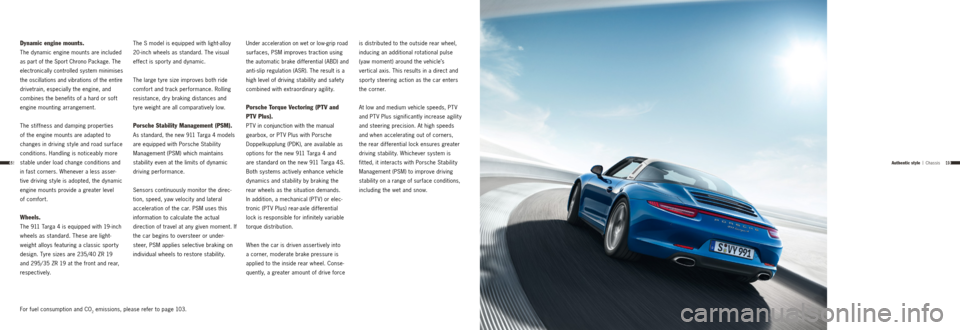
4948
Dynamic engine mounts.
The dynamic engine mounts are included
as part of the Sport Chrono Package. The
electronically controlled system minimises
the oscillations and vibrations of the entire
drivetrain, especially the engine, and
combines the benefits of a hard or soft
engine mounting arrangement.
The stiffness and damping properties
of the engine mounts are adapted to
changes in driving st yle and road surface
conditions. Handling is noticeably more
stable under load change conditions and
in fast corners. Whenever a less asser -
tive driving st yle is adopted, the dynamic
engine mounts provide a greater level
of comfort.
Wheels.
The 9 11 Targa 4 is equipped with 19-inch
wheels as standard. These are light-
weight alloys featuring a classic sport y
design. Tyre sizes are 235/40 ZR 19
and 295/35 ZR 19 at the front and rear,
respectively.
For fuel consumption and CO
2 emissions, please refer to page 103. The S model is equipped with light-alloy
20-inch wheels as standard. The visual
effect is sport y and dynamic.
The large t yre size improves both ride
comfort and track performance. Rolling
resistance, dry braking distances and
t yre weight are all comparatively low.
Porsche Stability Management (PSM).
As standard, the new 9 11 Targa 4 models
are equipped with
Porsche Stability
Management (PSM) which maintains
stabilit y even at the limits of dynamic
driving performance.
Sensors continuously monitor the direc -
tion, speed, yaw velocit y and lateral
acceleration of the car. PSM uses this
information to calculate the actual
direction of travel at any given moment. If
the car begins to oversteer or under -
steer, PSM applies selective braking on
individual wheels to restore stability.
Under acceleration on wet or low-grip road
surfaces, PSM improves traction using
the automatic brake differential (ABD) and
anti-slip regulation (ASR). The result is a
high level of driving stabilit y and safet y
combined with extraordinary agility.
Porsche Torque Vectoring (PTV and
PTV Plus).
PTV in conjunction with the manual
gearbox, or PT V Plus with Porsche
Doppelkupplung (PDK), are available as
options for the new 911 Targa 4 and
are standard on the new 9 11 Targa 4S.
Both systems actively enhance vehicle
dynamics and stabilit y by braking the
rear wheels as the situation demands.
In addition, a mechanical (PT V) or elec -
tronic (PT V Plus) rear-axle differential
lock is responsible for infinitely variable
torque distribution.
When the car is driven assertively into
a corner, moderate brake pressure is
applied to the inside rear wheel. Conse -
quently, a greater amount of drive force is distributed to the outside rear wheel,
inducing an additional rotational pulse
(yaw moment) around the vehicle’s
vertical axis. This results in a direct and
sport y steering action as the car enters
the corner.
At low and medium vehicle speeds, PT V
and PT V Plus significantly increase agilit y
and steering precision. At high speeds
and when accelerating out of corners,
the rear differential lock ensures greater
driving stability. Whichever system is
fitted, it interacts with Porsche Stability
Management (PSM) to improve driving stabilit y on a range of surface conditions,
including the wet and snow.
Authentic style | Chassis
Page 26 of 54
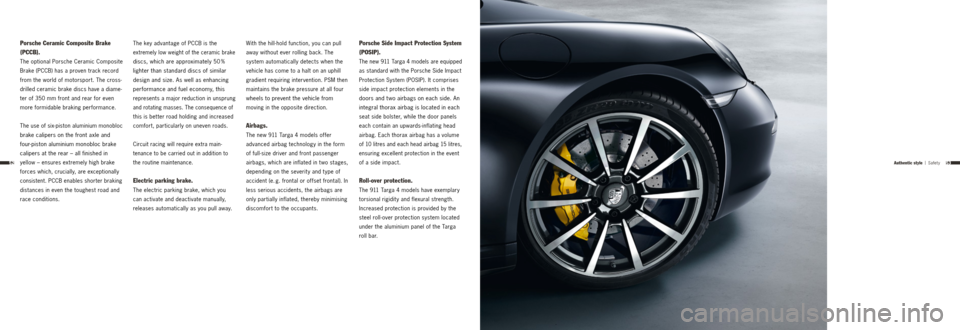
5352
Porsche Ceramic Composite Brake
(PCCB).
The optional Porsche Ceramic Composite
Brake (PCCB) has a proven track record
from the world of motorsport. The cross-
drilled ceramic brake discs have a diame -
ter of 350 mm front and rear for even
more formidable braking performance.
The use of six-piston aluminium monobloc
brake calipers on the front axle and
four-piston aluminium monobloc brake
calipers at the rear – all finished in
yellow – ensures extremely high brake
forces which, crucially, are exceptionally
consistent. PCCB enables shorter braking
distances in even the toughest road and
race conditions. The key advantage of PCCB is the
extremely low weight of the ceramic brake
discs, which are approximately 50
%
lighter than standard discs of similar
design and size. As well as enhancing
performance and fuel economy, this
represents a major reduction in unsprung
and rotating masses. The consequence of
this is bet ter road holding and increased
comfort, particularly on uneven roads.
Circuit racing will require extra main -
tenance to be carried out in addition to
the routine maintenance.
Electric parking brake.
The electric parking brake, which you
can activate and deactivate manually,
releases automatically as you pull away. With the hill-hold function, you can pull
away without ever rolling back. The
system automatically detects when the
vehicle has come to a halt on an uphill
gradient requiring intervention. PSM then
maintains the brake pressure at all four
wheels to prevent the vehicle from
moving in the opposite direction.
Airbags.
The new 911 Targa 4 models offer
advanced airbag technology in the form
of full-size driver and front passenger
airbags, which are inflated in t wo stages,
depending on the severit y and t ype of
accident (e. g. frontal or offset frontal). In
less serious accidents, the airbags are
only partially inflated, thereby minimising
discomfort to the occupants.
Porsche Side Impact Protection System
(POSIP).
The new 9 11 Targa 4 models are equipped
as standard with the Porsche Side Impact
Protection System (POSIP). It comprises
side impact protection elements in the
doors and t wo airbags on each side. An
integral thorax airbag is located in each
seat side bolster, while the door panels
each contain an upwards-inflating head
airbag. Each thorax airbag has a volume
of 10 litres and each head airbag 15 litres,
ensuring excellent protection in the event
of a side impact.
Roll-over protection.
The 911 Targa 4 models have exemplary
torsional rigidit y and flexural strength.
Increased protection is provided by the
steel roll-over protection system located
under the aluminium panel of the Targa
roll bar.
Authentic style | Safety
Page 28 of 54
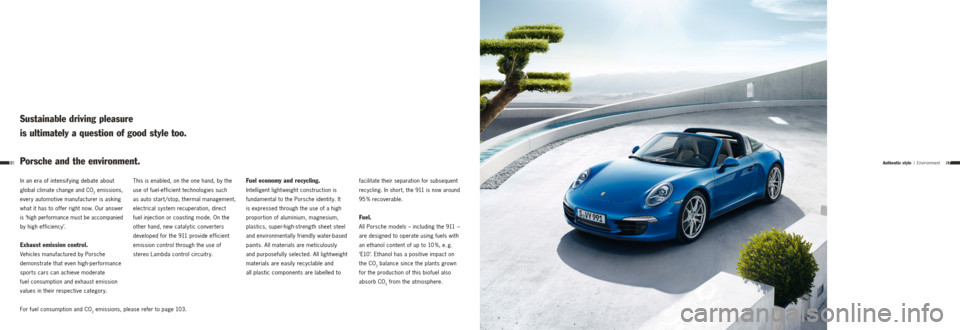
5756
In an era of intensifying debate about
global
climate change and CO2 emissions,
every automotive manufacturer is asking
what it has to offer right now. Our answer
is ‘high performance must be accom panied
by high efficiency’.
Exhaust emission control.
Vehicles manufactured by Porsche
demonstrate that even high-performance
sports cars can achieve moderate
fuel consumption and exhaust emission
values in their respective category. This is enabled, on the one hand, by the
use of fuel-efficient technologies such
as auto start /stop, thermal management,
electrical system recuperation, direct
fuel injection or coasting mode. On the
other hand, new cataly tic converters
developed for the 911 provide efficient
emission control through the use of
stereo Lambda control circuitry.
Sustainable driving pleasure
is ultimately a question of good style too.
Porsche and the environment.
Fuel economy and recycling.
Intelligent lightweight construction is
fundamental to the Porsche identit y. It
is expressed through the use of a high
proportion of aluminium, magnesium,
plastics, super-high-strength sheet steel
and environmentally friendly water-based
paints. All materials are meticulously
and purposefully selected. All lightweight
materials are easily recyclable and
all plastic components are labelled to
facilitate their separation for subsequent
recycling. In short, the 911 is now around
95 % recoverable.
Fuel.
All Porsche models – including the 911 –
are designed to operate using fuels with
an ethanol content of up to 10 %, e. g.
‘E10’. Ethanol has a positive impact on
the CO
2 balance since the plants grown
for the production of this biofuel also
absorb CO
2 from the atmosphere.
Authentic style | Environment
For fuel consumption and CO2 emissions, please refer to page 103.
Page 51 of 54
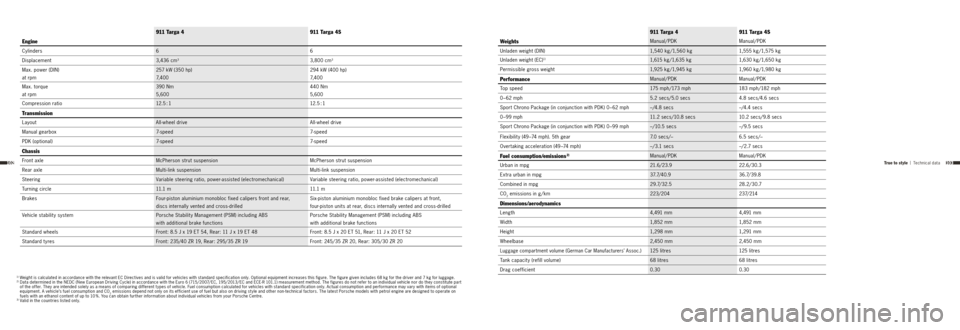
103102True to style | Technical data
911 Targa 4911 Targa 4S
Weights
Manual/PDK Manual/PDK
Unladen weight (DIN) 1,5 4 0 k g / 1,5 6 0 k g1,555 kg /1,575 kg
Unladen weight (EC)
1)1,615 k g / 1,6 35 k g 1,6 3 0 k g / 1,65 0 k g
Permissible gross weight 1,925 k g / 1,9 45 k g1,9 6 0 k g / 1,9 8 0 k g
PerformanceManual/PDKManual/PDK
Top speed 175 mph/173 mph183 mph/182 mph
0 – 62 mph 5.2 secs/5.0 secs4.8 secs/4.6 secs
Sport Chrono Package (in conjunction with PDK) 0 – 62 mph –/4.8 secs–/4.4 secs
0 –99 mph 11.2 secs/10.8 secs10.2 secs/9.8 secs
Sport Chrono Package (in conjunction with PDK) 0 –99 mph –/10.5 secs–/9.5 secs
Flexibilit y (49 –74 mph). 5th gear 7.0 secs/–6.5 secs/–
Overtaking acceleration (49–74 mph) –/3.1 secs–/2.7 secs
Fuel consumption/emissions 2)Manual/PDKManual/PDK
Urban in mpg 21.6/ 23.922.6/30.3
Extra urban in mpg 3 7. 7/ 4 0 . 936.7/39.8
Combined in mpg 2 9 . 7/ 3 2 . 528.2 / 3 0.7
CO
2 emissions in g / km 223/2042 3 7/ 2 14
Dimensions/aerodynamics
Length 4,491 m m4,491 m m
Width 1,8 52 m m1,8 52 m m
Height 1, 2 9 8 m m1, 2 91 m m
Wheelbase 2,450 mm2,450 mm
Luggage compartment volume (German Car Manufacturers’ Assoc.) 125 l i t re s125 l i t re s
Tank capacity (refill volume) 68 litres68 litres
Drag coefficient 0.300.30
911 Targa 4 911 Targa 4S
Engine
Cylinders 6 6
Displacement 3,436 cm
33,800 cm3
Max. power (DIN)
at rpm257 kW (350 hp)
7, 4 0 0 294 kW (400 hp)
7, 4 0 0
Max. torque
at rpm 390 Nm
5,600 440 Nm
5,600
Compression ratio 12.5 : 1 12.5 : 1
Transmission
LayoutAll-wheel drive All-wheel drive
Manual gearbox 7-speed 7-speed
PDK (optional) 7-speed 7-speed
Chassis
Front a xleMcPherson strut suspension McPherson strut suspension
Rear axle Multi-link suspension Multi-link suspension
Steering Variable steering ratio, power-assisted (electromechanical) Variable steering ratio, power-assisted (electromechanical)
Turning circle 11.1 m 11.1 m
Brakes Four-piston aluminium monobloc fixed calipers front and rear,
discs internally vented and cross-drilled Six-piston aluminium monobloc fixed brake calipers at front,
four-piston units at rear, discs internally vented and cross- drilled
Vehicle stability system Porsche Stability Management (PSM) including ABS
with additional brake functions
Porsche Stability Management (PSM) including ABS
with additional brake functions
Standard wheels Front: 8.5 J x 19 ET 54, Rear: 11 J x 19 ET 48 Front: 8.5 J x 20 ET 51, Rear: 11 J x 20 ET 52
Standard tyres Front: 235/40 ZR 19, Rear: 295/35 ZR 19 Front: 245/35 ZR 20, Rear: 305/30 ZR 20
1) Weight is calculated in accordance with the relevant EC Directives and is valid for vehicles with standard specification only. Optional equipment increases this figure. The figure given includes 68 kg for the driver and 7 kg for luggage.2) Data determined in the NEDC (New European Driving Cycle) in accordance with the Euro 6 (715/2007/ EC, 195/2013/ EC and ECE- R 101.1) measurement method. The figures do not refer to an individual vehicle nor do they constitute par t
of the of fer. They are intended solely as a means of comparing dif ferent t ypes of vehicle. Fuel consumption calculated for vehicles with standard specification only. Actual consumption and per formance may var y with items of optional
equipment. A vehicle’s fuel consumption and CO
2 emissions depend not only on its ef ficient use of fuel but also on driving st yle and other non -technical factors. The latest Porsche models with petrol engine are designed to operate on
fuels with an ethanol content of up to 10 %. You can obtain fur ther information about individual vehicles from your Porsche Centre.
3) Valid in the countries listed only.
Page 53 of 54
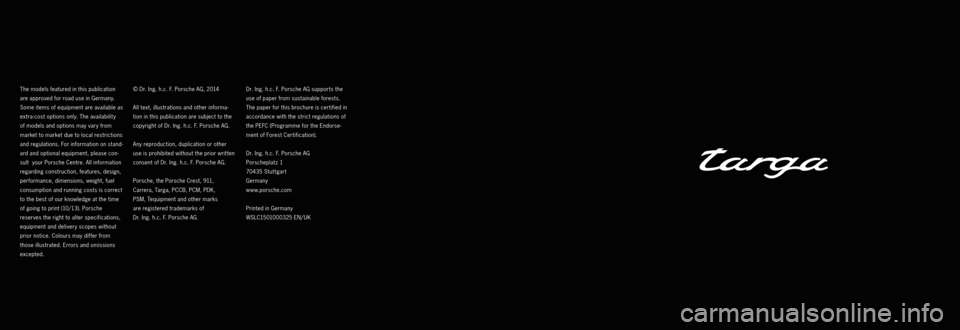
The models featured in this publication
are approved for road use in Germany.
Some items of equipment are available as
extra-cost options only. The availability
of models and options may vary from
market to market due to local restrictions
and regulations. For information on stand -
ard and optional equipment, please con -
sult your Porsche Centre. All information
regarding construction, features, design,
performance, dimensions, weight, fuel
consumption and running costs is correct
to the best of our knowledge at the time
of going to print (10/13). Porsche
reserves the right to alter specifications,
equipment and delivery scopes without
prior notice. Colours may differ from
those illustrated. Errors and omissions
excepted. © Dr. Ing. h.c. F.
Porsche AG, 2014
All text, illustrations and other informa -
tion in this publication are subject to the
copyright of Dr. Ing. h.c. F. Porsche AG.
Any reproduction, duplication or other
use is prohibited without the prior written
consent of Dr. Ing. h.c. F. Porsche AG.
Porsche, the Porsche Crest, 911,
Carrera, Targa, PCCB, PCM, PDK,
PSM, Tequipment and other marks
are registered trademarks of
Dr. Ing. h.c. F. Porsche AG.
Dr. Ing. h.c. F.
Porsche AG supports the
use of paper from sustainable forests.
The paper for this brochure is certified in
accordance with the strict regulations of
the PEFC (Programme for the Endorse -
ment of Forest Certification).
Dr. Ing. h.c. F. Porsche AG
Porscheplatz 1
70435 Stut tgart
Germany
www.porsche.com
Printed in Germany
WSLC1501000325 EN/UK